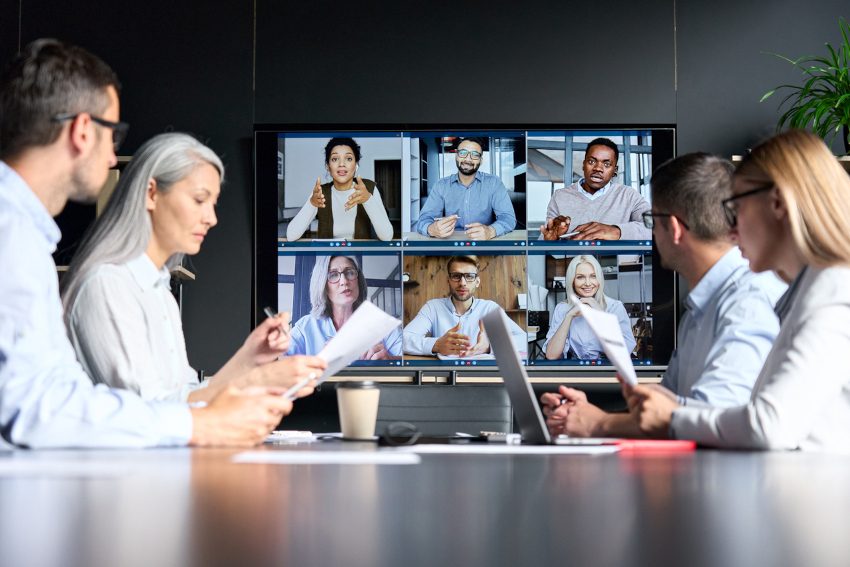Effective Ways to Collaborate in Corporate and Government Offices
Is it possible to create a collaborative culture where the entire team feels comfortable sharing ideas and working together? In today’s competitive environment, companies need to work smarter and faster to stay ahead of their competitors and create a collaborative environment. Ideally, implementing collaboration tools can raise productivity by 25%.

Collaboration is a vital part of communication. When people communicate well, they can solve problems faster, build better relationships, and achieve their goals. Besides, a culture of collaboration has become essential thanks to collaboration software and tools like Slack, Microsoft Teams, Google Docs, and others. Moreover, it is a skill that can be learned and improved.
Collaboration strategies require you to break down barriers between remote teams, departments, and individuals to foster teamwork. That calls for effective communication through open communication lines and mutual respect. Given these factors, here are some practical ways to promote collaboration in government and corporate offices.
1. Collaborating at the Right Level
A collaborative workplace involves cultivating mutual respect, a shared vision, and an understanding of each other’s roles to help employees achieve stellar business outcomes and enhanced customer experience. Most organizations try to solve problems at the individual team or department level. This approach misses out on critical information required to make decisions. Instead, focus on the entire team to promote collaboration.
Corporate offices must encourage interdepartmental collaboration from the ground level. They can achieve that by dictating and structuring their team’s interdepartmental interactions thoughtfully and purposefully. For instance, using project management software enhances collaborative work between teams.
2. Use Consistent Communication Tools
Many organizations continue to communicate via email while ignoring the power of the web to promote collaboration. However, there are new technologies that can deliver real-time messaging to members of the team across various geographic locations. Using these innovations ensures that everyone knows about important events, updates, and changes.
Use apps like Slack to facilitate team integration and interactions by reviewing and commenting on each member’s contribution to a project. Such tools eliminate the back-and-forth responses when using email. Additionally, they automate notifications to allow the relevant team members to see them and also enable the team members to see the entire project’s workflow.
3. Provide the Right Context
It gets hard for teams to collaborate without feeling motivated. So, effective collaboration requires you to provide context and understanding of why they need to collaborate. You also must demonstrate the impact of this collaboration on the overall business performance. Therefore, give a holistic project view for each department to understand their role in achieving a common goal. Moreover, encourage them to share information with other departments on shared objectives.
Begin by having cross-departmental meetings and video conferencing at the beginning of a project. Then, invite the leadership team to set the vision and begin the conversation. Also, encourage project management software to manage every aspect of the project to keep your team engaged. Employee disengagement costs the US economy over$350B annually through accidents, theft, lost productivity, and turnover, and you want to avoid this.

You can also create feedback loops to let employees note the impact of their strengths on a project. When a common goal guides teams and they understand how they fit into the larger context, they become empowered. They also take the initiative for successful collaboration and increased positivity.
4. Build Relationships Between Employees
Government and corporate offices should encourage cross-functional collaboration instead of siloed thinking. They also need to create a work environment where staff members build trust. Empowering employees to contribute ideas and suggestions allows them to gain ownership over projects and tasks.
Mutual understanding between teams makes collaboration effective and smoother. So, cultivate empathy by encouraging employees to walk a day in another employee’s shoes to see their department’s challenges from a different perspective.
In addition, it helps them understand different departments’ challenges and cultivate curiosity. Doing so can help them learn each department’s work and generate ideas of how each team can improve their work process. In the long run, it’ll encourage other groups to work effectively.
Also, encourage teams within corporate offices to embrace a mindfulness culture. Employees can better relate with coworkers productively and positively to achieve their shared objectives when they keep tabs on their emotions.
5. Use Digital Signage
Digital signage is an effective way to communicate important updates with all employees. You should develop a company culture and everyday language that you can easily share with new members during orientation. Also, avoid using department-specific jargon as it can make communication challenging since it alienates the employees in other departments.
Furthermore, use strategic digital signage locations for effective and fast communication with the employees. For example, you can use the displays to announce team meetings, hold brainstorming sessions, or indicate team goals and timelines. Use different content to get employees’ attention, improve engagement, and promote collaboration.
6. Create a Corporate Culture
Many corporate and government offices don’t see the need and value of weekly stand-ups. They may seem like a waste of time but can have a profound positive impact on communication and morale. The stand-ups can lead to better retention of staff and revenue. You can host weekly stand-ups where representatives from all departments discuss their challenges and projects. Discussions concerning the team’s success can help different groups stay informed and keep learning.
Fridays are ideal for meetings since employees are more relaxed and workweek events are still fresh in their minds. Such weekly stand-ups help in putting a face to departments outside daily standard work tasks. The ultimate goal is establishing relationships among organization staff, founding them on positive feelings. Consequently, employees are encouraged to report to each other when issues arise in their departments.
7. Develop a Common Language

Jargon and department-specific language can alienate workers from other teams. Communication also becomes a challenge. Thereafter, confusion can arise when teams fail to have a common understanding of terminologies used for interdepartmental communications. Not only do they get frustrated on the back and forth, but there’s a risk of miscommunication that can derail the whole project.
To improve your company’s cross-functional communication:
- Develop a common language that you share when onboarding new members
- Learn from your past miscommunications and check where misunderstandings and disconnects took place
- When you introduce a common language, anticipate a learning curve
- Involve team members in the development process.
Some workspaces can hardly avoid the use of technical language for specific functions. As such, encourage team players to learn the basic terms used in other departments to communicate effectively daily.
8. Celebrate Wins
Use digital signage to celebrate wins and milestones by displaying them on digital screens. Additionally, you can acknowledge different team members’ roles and their individual strengths and skill sets in the success. Such recognition motivates employees and enhances a culture of respect and trust among team members to promote collaboration. Scientific research shows that celebrating employees for work well done can help create a more sustainable drive than financial incentives.
Don’t limit celebrations to project completions only. Create a set of milestones and make it a habit to celebrate all the small wins. Small wins help sustain motivation and momentum while breaking barriers and silo walls. Winning feels good, and to attain wins, you need to promote collaboration at the interdepartmental level. Acknowledging such provides positive reinforcement for future teamwork.
Celebrations shouldn’t always be elaborate; a company can sponsor a happy hour or catered lunch. The minimal plans can allow company staff to mingle as they share insights.
9. Multisector Collaboration
Multisector collaboration is similar to the different methods described above. However, it has tremendous potential for change and can create competitive challenges. Public, private, and nonprofit organizations from different community sections and private citizens sometimes form a partnership. From those partnerships, they coordinate their efforts in solving systematic problems in their community.
Community problems can include:
- Failing health and educational system
- Poor business climate
- Unskilled workforce
Intertwined and complex problems like those mentioned above require community cooperation to make positive changes. One sector or organization can’t make a significant movement without cooperation and help from other sectors. So, multisector collaborations are often necessary when an organization or sector tries to solve problems alone and fails.

Different groups come together, define the problem, and plan and implement a strategy like preparing young people for skills. Such skills will help them get employment in the sectors within the community.
Promoting collaboration at the multisector level is more complex and challenging than any other organizational relationship. It requires all parties involved to set aside their narrow interests and prioritize the broader common good of the larger community. Everyone in the collaboration team has to understand how to solve fundamental problems affecting the whole community. That gives them a better chance to meet the community’s overall goals.
Multisector collaboration has the most significant opportunity to empower communities. It’s the only place members become equal players with government and business in making decisions that affect the community.
How’s Your Team’s Collaboration Between Departments?
Workplace collaboration is a core competency for organizations to thrive in the global economy. As a result, governments are investing heavily in collaborative initiatives to enhance efficiency and effectiveness in public service delivery. When you promote collaboration and team-building activities, you streamline and align your employees at every level and connect them to achieving team goals.



